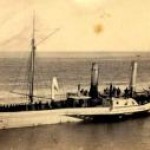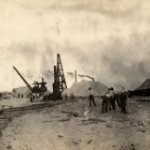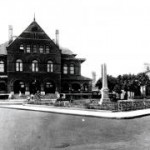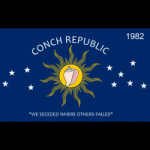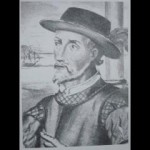FL Div Hist Res
Civil War Union Blockade
Following President Lincoln’s order for a naval blockade of Confederate ports in 1861, the U.S. Navy established the East Gulf Blockading Squadron at Fort Jefferson, Fort Taylor, and the port of Key West. The squadron’s area of operations stretched from Cape Canaveral to Pensacola. More than 300 blockade runners’ ships were intercepted from 1861 thru 1865. Many historians believe Key West’s strategic location and the squadron’s success in blockading southern ports severely reduced Confederate supply lines and shortened the duration of the Civil War.
The Outer Mole
The origins of the Mole Pier date back to several years before the Civil War. It was a wooden dock for Fort Taylor. With plans to expand the Naval Station into a submarine base following World War I, engineers redesigned and extended the pier as a concrete breakwater for the harbor. The Navy retained ownership of the pier after the sale of the Naval Station in 1986. It is currently used by the Navy, Coast Guard, NOAA, and cruise ships.
Clinton Square
This monument represents two perspectives on how the Civil War affected the residents of Key West. The obelisk in the center of the memorial plot was erected by the Navy Club of Key West for the Union soldiers who lost their lives in Key West during the Civil War. The metal fence surrounding the obelisk was erected by R.Vining Harris, a staunch Confederate and the father of the builder of the Southernmost House, to memorialize the loss of Confederate soldiers.
The Conch Republic
On April 23, 1982, the CONCH REPUBLIC declared secession of the Florida Keys from the United States. The short lived “war†was in response to a border patrol check point in Florida City subjecting all vehicles to searches for illegal immigrants. After announcing the “Proclamation of War†federal agents in attendance were attacked with stale loafs of Cuban bread followed by an immediate surrender of the Republic. The road block was removed but the secession and foreign aid demands have never been recognized.
Ponce de Leon
In 1513, one of the most famous Spanish explorers discovered and named Florida for the Spanish Empire. He initially believed that the land mass was a large island. His discovery of the Gulf Stream would change maritime travel for centuries to come. En route to the Gulf Coast of Florida he traversed the Florida Keys and discovered the Dry Tortugas. “Tortugas†is Spanish for turtle and “Dry†refers to the lack of fresh water on the islands.
